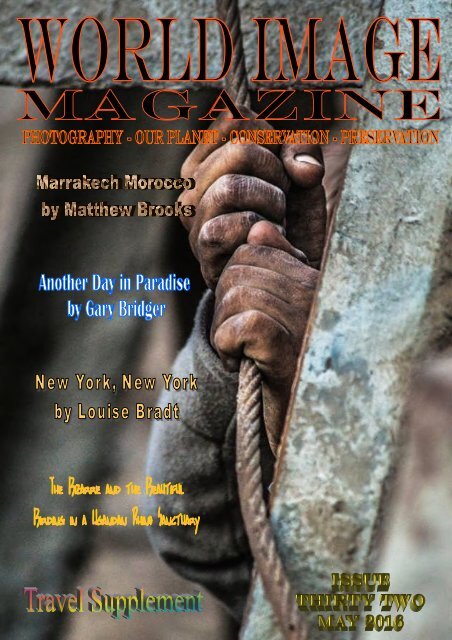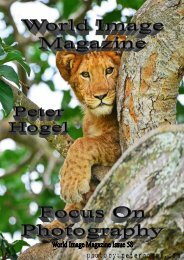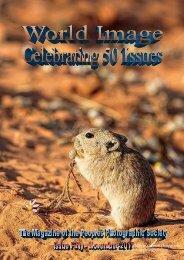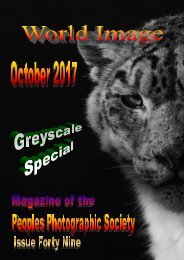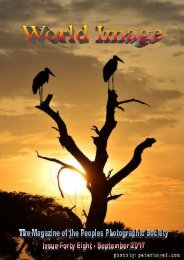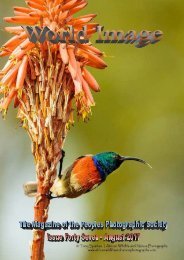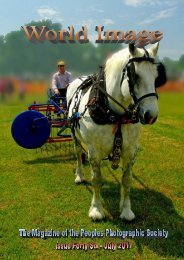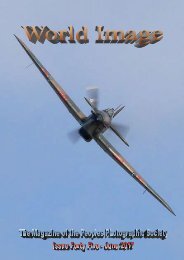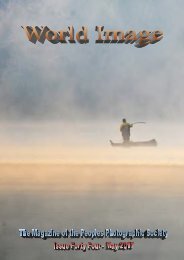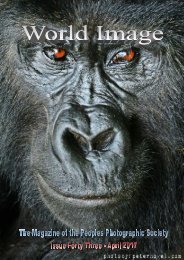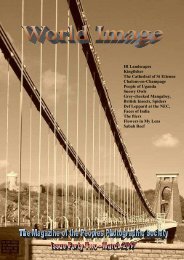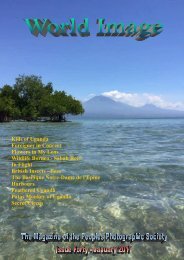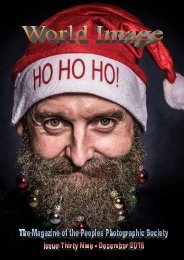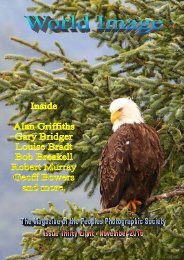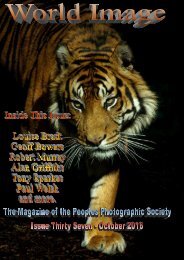World Image Issue 32 May 2016
The free global magazine of the PPS, dedicated to photography, conservation and the preservation of our planet and all the natural life that survives upon it.
The free global magazine of the PPS, dedicated to photography, conservation and the preservation of our planet and all the natural life that survives upon it.
Create successful ePaper yourself
Turn your PDF publications into a flip-book with our unique Google optimized e-Paper software.
Website = www.worldimagemag.com Page 1 email = magazine@photosociety.net
National and Regional Management<br />
Gordon Longmead - England - CEO<br />
Peter Hogel - Uganda - Deputy CEO<br />
Scott Hurd - Namibia<br />
Tom Coetzee - South Africa<br />
Paul Welch—Australia<br />
Steve Cook - USA<br />
Robert Murray - Scotland<br />
Tina Andreasson - Sweden and Mexico<br />
Jack Glisson - Kentucky USA<br />
Rodger Lee - Steam Punk Events<br />
4 Architectural Wonders - A Study in Greyscale Pictures by Alan Griffiths<br />
6 The Netherlands, Ardennes, Part 3, streams and brooks. by Paul Weijenberg<br />
10 Street Scene Photography<br />
14 Challenge Highly Sprung<br />
16 Wild Horses of Namibia by Scott and Judy Hurd<br />
18 Panoramas … Yes You Can Shoot Them by Geoff Bowers<br />
22 Wildlife Borneo - Another Day in Paradise 4, Sabah Reef by Gary Bridger<br />
24 A Study in Nature - Wildlife of America - Snow Geese by Larry Hitchins<br />
25 Animals with Attitude by Gordon Longmead<br />
26 New York, New York Pictures by Louise Bradt<br />
28 Oh We Do Like To Be Beside The Seaside Pictures by Alan Griffiths<br />
<strong>32</strong> The Bizarre and the Beautiful, Birding in a Ugandan Rhino Sanctuary<br />
36 A Study in Nature, Grouse, Pheasant, Woodpecker and Blackbird Pictures by Scott Latham<br />
37 Two by Tony<br />
38 Uganda, Birds of the Victoria Nile - Murchison National Park by Gordon Longmead<br />
40 Lake Superior, Minnesota “The Land of 10,000 Lakes" by Georgene Bergstrom<br />
41 Two by Scott - Dipper - Pictures by Scott Latham<br />
42 Big and Small Pictures by Louise Bradt<br />
43 A Study in Faces - Portraiture greyscale vs colour Pictures by Gordon Longmead<br />
44 Sparrow Hawk Pictures by Scott Latham<br />
45 "<strong>2016</strong> Indian Roadmaster" By Louise Bradt<br />
Heron by Brian Chalmers<br />
46 Push Your Imagination<br />
47 Photo Spot - Marrakech Morocco by Matthew Brooks<br />
55 Travel Supplement<br />
<strong>World</strong> <strong>Image</strong> Magazine on Fine Art America<br />
Peoples Photographic Society Member galleries<br />
http://gordon-longmead.artistwebsites.com/index.html?tab=galleries<br />
As part of the expansion and ongoing development of the <strong>World</strong><br />
<strong>Image</strong> Magazine, we have established a website presence within Fine<br />
Art America for the presentation and promotion, and sale of member<br />
images.<br />
Members wishing to add their own gallery should contact Gordon@worldimagemag.co.uk for<br />
details.<br />
© Please remember that all articles and images published in this magazine are copyright protected<br />
Cover Picture by Karim Ahmed<br />
Website = www.worldimagemag.com Page 2 email = magazine@photosociety.net
Members of the<br />
Peoples Photographic<br />
Society and subscribers to the<br />
magazine can benefit from one years free<br />
membership of the Academy.<br />
For details please go to group or contact<br />
lendasnow@hotmail.co.uk to register with the society (free) and obtain<br />
access details.<br />
In a recent communication to the editor it was intimated that it is not right and proper for a magazine to<br />
publish pictures and articles without paying the person submitting them. It is apparently considered<br />
unprofessional and unfair to professional writers and photographers.<br />
While the editor considers this to be a fair and reasonable statement in regard to those magazines and<br />
periodicals that charge the reader for the privilege of reading their pages, it is worth remembering that this<br />
magazine is currently free.<br />
It is designed to showcase the non-professional alongside the professionals who want to inspire others.<br />
Their return on this investment is exposure to an audience that simply can not afford to pay for<br />
subscriptions, (especially for magazines that are 70% advertising), and the knowledge that beginners can<br />
learn and be encouraged to participate.<br />
We encourage the non-professional to submit pictures and write articles, ordinary, unassuming people<br />
who would never be considered for mainstream magazines because they are ‘unknown’, and we will<br />
continue along that path for as long as we have the support.<br />
We will not pay for articles or submissions, but will welcome them. By the same token, we will not charge<br />
you to read this magazine.<br />
One final note, have you ever wondered how a photographer becomes ‘known’, or how much money they<br />
spend to achieve that status? While many are great, more are great in their own eyes only, and many more<br />
are as good as or better than the great.<br />
Website = www.worldimagemag.com Page 3 email = magazine@photosociety.net
Architectural Wonders - A Study in Greyscale<br />
Pictures by Alan Griffiths<br />
When we look at buildings, I wonder how many of us<br />
think ‘Boring’.<br />
Of course much of our modern architecture is just that,<br />
boring, comprising a brick or concrete box with a door<br />
and a few windows.<br />
It is interesting to see that when we pulled this study<br />
together, there was only these images of a modern<br />
building.<br />
Even these have the ‘old’ tucked away in the background.<br />
Looking at the older buildings we see a much greater variety of style<br />
and structure, and even the materials from which they are<br />
constructed. All of these elements combine to create interest in the<br />
view.<br />
When we visit cities we tend to<br />
aim the lens to the mega<br />
structures, keeping the nearby<br />
buildings as low key as possible,<br />
but are we right?<br />
We can challenge the traditional<br />
as in the pictures of York Minster<br />
and St Pauls Cathedral.<br />
By using the local buildings we<br />
get a better sense of the area, and<br />
also the desire to see more of the<br />
main building.<br />
York Minster<br />
St Pauls by Alan Griffiths<br />
Website = www.worldimagemag.com Page 4 email = magazine@photosociety.net
While we often dislike the weather, it<br />
can play an important part in the<br />
construction of a photograph.<br />
A right sort of cloud cover in the sky,<br />
coupled with the angle and foreground<br />
contrast, and of course the careful<br />
framing of the scene, creates a dramatic<br />
greyscale image<br />
When viewed in colour these ‘chocolate<br />
box’ or ‘jigsaw puzzle’ images are still<br />
powerful, but the tonal quality of the<br />
greyscale lends the drama.<br />
Home by Alan Griffiths<br />
Reflection plays a part in most images, whether it is in a river or puddle,<br />
or even a vehicle windscreen.<br />
We have two different examples of<br />
how reflections can be used in<br />
Durham Massey and the power<br />
station.<br />
Another point of interest is raised by<br />
these last three images, is that the<br />
buildings, while the main subject,<br />
do not need to fill the frame.<br />
The area around the main subject is<br />
often as important as the subject<br />
itself. It puts the building in context<br />
and can often provide the visual<br />
story that goes with it.<br />
Power Station by Alan Griffiths<br />
Dunham Massey by Alan Griffiths<br />
The lighting plays an important part<br />
in any picture, architecture is no<br />
different.<br />
We can change the depth of colour, and even invert it during post<br />
processing. Most packages have the means to change almost anything, but<br />
how valid the end result is down to you and the care you take. Sometimes,<br />
the natural lighting works in your favour by creating the desired effect<br />
when the picture is taken.<br />
What ever the style you adopt in the picture, it is worth remembering that<br />
different subjects work in different ways and by experimenting with the<br />
different styles you will get the image that stands out from the crowd.<br />
Gordon<br />
The Empire Great Yarmouth<br />
Website = www.worldimagemag.com Page 5 email = magazine@photosociety.net
There are numerous streams and brooks in the<br />
Ardennes. Sawe, Statte, Getzbach, Soor, Helle,<br />
Ninlingspo, Polleur, Hoegne, Spohrbach, Steinbach,<br />
Eisernbach to name a few.<br />
There are even (origins of) rivers (Ambleve,<br />
Berwinne, Ruhr) in these Ardennes. The French<br />
names are from the western regions, the German<br />
names are found in the Eastern regions.<br />
This time we look at a few of these streams. Often<br />
you have to plan your trip carefully, you must know<br />
where you can cross these waters.<br />
There are bridges, but in the past, some of the<br />
bridges were washed away by the rising water after<br />
the winter season.<br />
You must know the second crossing point. The<br />
bridges that will be up, are made of stone and<br />
concrete. The next bridge is often quite a distance<br />
away though…<br />
Large parts of the Ardennes are being of have<br />
already been stripped of trees. They were often firs,<br />
these trees never liked the acid environment.<br />
The Netherlands, Ardennes,<br />
Part 3, streams and brooks.<br />
By Paul Weijenberg<br />
Second problem with all those trees: they drank all<br />
the rain, left too little for the fresh water lakes that<br />
are the source for drinking water in East Belgium.<br />
When the trees were gone, sooner than expected, the<br />
water came back and fed once again the streams,<br />
ending in the lakes.<br />
Some 10 years ago, this stream held so little water,<br />
that you could easily step over it. It had no<br />
significance for walks through this terrain.<br />
Nowadays it is a real barrier.<br />
Website = www.worldimagemag.com Page 6 email = magazine@photosociety.net
Many steams carry metal, red indicates iron, hence<br />
the name Eisernbach. Most streams in the Ardennes<br />
carry iron, and have red water. Eau Rouge tells it all.<br />
Website = www.worldimagemag.com Page 7 email = magazine@photosociety.net
The water descents from around 600 m to 300 m<br />
altitude. All the time, little brooks become streams<br />
and streams become rivers.<br />
Some lakes are deeper than you would think.<br />
Below the Helle and the Ambleve downstream.<br />
Early spring, or the end of the winter is best to see<br />
the water flow. Most images here are made for<br />
march to early may.<br />
Downstream the water flows slower, causing algae<br />
to grow on the stones.<br />
Website = www.worldimagemag.com Page 8 email = magazine@photosociety.net
In this area, most of the trees in the higher regions<br />
will vanish, to favour the water level in the streams.<br />
For wanderers this is beneficial too, you can look<br />
over much greater distances ahead. Most of the trees<br />
you see in the next image are gone now, but here<br />
you can see how obstructed the view is. In the<br />
Ardennes, it is good to check your map all the time,<br />
you just have to know exactly where you are at all<br />
times.<br />
There are brooks that carry little water all year.<br />
Next time is the last visit to this vast area of the<br />
Ardennes. From where I live, it takes a drive of just<br />
30 minutes to this area, so I hike here frequently.<br />
Paul.<br />
Website = www.worldimagemag.com Page 9 email = magazine@photosociety.net
Street scene photography is just what it states on<br />
the label. It is those images we take on the<br />
highways and byways that pass through our cities,<br />
towns and villages.<br />
They can encompass everything from vehicles and<br />
traffic to children playing to people working. It<br />
shows life on the streets and the rubbish and<br />
dereliction we leave behind. It presents the old<br />
and the new through the eyes of the photographer.<br />
There is a crossover, the discussion is ongoing as to<br />
what is street scene and what is a cityscape. Both can<br />
include people and buildings, but for me, cityscape<br />
shows the overview of the scene while the street scene<br />
shows the life of the street.<br />
Street scene photography is not about passing<br />
judgement, it is about presenting what is there in the<br />
most powerful or descriptive way possible, but without<br />
bias.<br />
Boy by Karim Ahmed<br />
It does not matter if the image is the urchin standing<br />
beside the rubbish on the street or the Queen in the<br />
royal coach.<br />
Website = www.worldimagemag.com Page 10 email = magazine@photosociety.net
Sometimes you do not even have to<br />
see the whole person or scene to<br />
convey the message.<br />
It happens that when presented in the<br />
proper way and carefully framed, the<br />
most powerful messages are created<br />
by the simplest of concepts.<br />
Like all images, and probably more<br />
so, the street scene image must tell the<br />
story, and it is down to the person<br />
behind the camera to ensure that the<br />
story is told within the frame.<br />
Struggle by Karim Ahmed<br />
Website = www.worldimagemag.com Page 11 email = magazine@photosociety.net
Of course in our modern society<br />
we also have streets going<br />
underground.<br />
Here care must be taken as most<br />
undergrounds are private<br />
property, and that includes the<br />
metro.<br />
Most of the time nothing will be<br />
said so long as you are not<br />
causing obstruction or a<br />
nuisance.<br />
I would certainly seek<br />
permission if you want to try it<br />
in the rush hour.<br />
Above ground anything goes so long as you do not step onto<br />
private property to take the picture. This includes<br />
those buildings with the grassed or<br />
parking areas to the<br />
front adjacent to the<br />
footpath. Step on those<br />
at your peril as most are<br />
private property, and<br />
sooner or later some<br />
jobsworth will challenge<br />
you.<br />
In London, as is probably<br />
the case in most cities, there<br />
are buildings that, although it<br />
is perfectly legal to take the<br />
pictures of, you will be<br />
challenged when doing so,<br />
often by people carrying guns.<br />
My advise is simple, when you<br />
see a gun toting police officer<br />
standing in the street, tell them<br />
what you are doing and why<br />
before you begin.<br />
They can not stop you, but they<br />
may chose to accompany you while<br />
you take the pictures.<br />
The area around the cenotaph is a good place in point, Having spoken to a police officer at one end of the<br />
street, he was still beside me at the other. Not every day you get an armed guard when taking pictures. They<br />
also have another aspect to their work in that some of them actually know quite a lot about the buildings<br />
they are guarding and, if they are in a good mood, will often tell you about them.<br />
Website = www.worldimagemag.com Page 12 email = magazine@photosociety.net
The rule of never presenting people in a bad light applies equally to street scene<br />
as to any other form of photography. Treat subjects in a respectful manner and<br />
present them in a way you would not be unhappy about in presenting yourself.<br />
Remember also not to impose on their space.<br />
As with any photography, take care of your equipment, know what and who is<br />
around you (they may be watching for an opportunity), stay away from<br />
unsavoury areas, watch for traffic.<br />
Above all, enjoy the day (or<br />
night), stay safe, and if you are in<br />
any doubt about the area you<br />
want to visit, take some mates<br />
with you.<br />
Website = www.worldimagemag.com Page 13 email = magazine@photosociety.net
2nd M<br />
Challenge Highly Sprung<br />
1st Geoff Bowers<br />
Website = www.worldimagemag.com Page 14 email = magazine@photosociety.net
3rd Alan Culley<br />
ichael Tweed<br />
4th Robert Murray<br />
Website = www.worldimagemag.com Page 15 email = magazine@photosociety.net
They were abandoned here<br />
in the Namibian desert by<br />
man after their services<br />
were no longer required<br />
for military use. Simply<br />
they were left in a<br />
hostile environment by<br />
hostile people who<br />
had no interest in<br />
their survival.<br />
While mindful of the fact that<br />
we have included these wild<br />
horses in past issues, the work<br />
of those trying to ensure their<br />
survival is, like most<br />
conservation projects, filled<br />
w i t h t r i a l s a n d<br />
disappointments.<br />
Some of these are man made<br />
while others are the result of natural events.<br />
The plight of these horses is a mixture of both.<br />
Against the odds, they did<br />
survive, roaming the desert in search<br />
of food and water, they have adapted to the harsh<br />
conditions that prevail in this hostile part of the world.<br />
Website = www.worldimagemag.com Page 16 email = magazine@photosociety.net
Their numbers remain small,<br />
only a few hundred in the<br />
herd, and how they have<br />
survived is still something of<br />
a mystery.<br />
Now they are being helped,<br />
not because they are<br />
incapable, but because of the<br />
drought that holds their world<br />
in its grip.<br />
Man provides salt licks<br />
which, although cheap, can<br />
sustain the herd when<br />
there is no food around<br />
for them.<br />
The resilience of the horses is a treat<br />
to see . In spite of their arid<br />
landscape, they are, or at least<br />
appear, happy to be free, enjoying<br />
dust baths seems to be the favourite<br />
past time.<br />
Website = www.worldimagemag.com Page 17 email = magazine@photosociety.net
Olinda Nr Recife Brazil<br />
Do you like “Panos” but think you need expensive<br />
equipment to shoot them?<br />
I have found that this is not true. All you need is a<br />
digital camera and a copy of a basic photo editing<br />
programme that will merge your shots.<br />
I use Photoshop Elements 13. My Olympus software<br />
does also work but I have to remember to put the<br />
camera in Panoramic mode before clicking.<br />
<br />
<br />
<br />
<br />
Hold the camera in portrait not landscape<br />
orientation<br />
Scan from left to right to check what the<br />
camera sees and the horizon<br />
Zoom in a bit to get closer to a further view<br />
Zoom back if to close, or step back if possible<br />
It is true that you can buy a panoramic head for your<br />
tripod and set up to get the perfect shots, but this is<br />
more expensive and you have to carry it around.<br />
OK if you have planned your shoot specifically but<br />
not so easy on a whim.<br />
My method suits impatient people like me. Usually I<br />
see the ‘view’ when I’m travelling on my holidays. I<br />
like to travel light so often I’m just carrying my<br />
Olympus OMD EM-5 Mk II with the 14-150mm<br />
lens. I have other kit but it gets left in the car, room<br />
or at home. Daft I know but ....<br />
<br />
<br />
<br />
<br />
<br />
Golden Gate Bridge<br />
Hold up your left hand in L shape as a pre<br />
marker for shot 1<br />
Start at the left of the scene and get the focus<br />
and Click<br />
Holding the horizon steady in the viewer move<br />
50% right and Click<br />
Keep going ‘til you’ve got it all in the camera<br />
Hold up your right hand in reverse L to mark<br />
the end of the sequence<br />
So, you’re walking along looking for birds or a<br />
flower or something and a view pops up. Here’s<br />
what I do:<br />
It’s surprising how many images will stitch together<br />
successfully in Photoshop Elements. One of my<br />
Uluru panos is 16 shots and the Olgas one is 14.<br />
Website = www.worldimagemag.com Page 18 email = magazine@photosociety.net
Wye bridge at Builth Wells<br />
Sometimes the stitching gives strange edges,<br />
especially if the images are a little out of line. Using<br />
the crop tool to crop inside these edges will give you<br />
a clean picture.<br />
I shoot lots of these, they don’t always work but hey<br />
its digital, it cost nothing to delete them, except a<br />
little time. Often they work very well and make<br />
great pictures you can put on your wall, and no one<br />
else has the same ones.<br />
Pitcairn Sunset<br />
If you are used to a little editing try cloning in bits<br />
of the sky that are missing. If the perspective is<br />
wrong try one of the different presets in the<br />
Panorama menu, again if you are up to it use the<br />
<strong>Image</strong> - Transform- Distort adjustment.<br />
Grab the corners of the image with the mouse<br />
pointer and pull them apart, upwards or any which<br />
way to distort the view into what you need. You will<br />
have created many layers so now go to Layer –<br />
Flatten <strong>Image</strong> and click to produce a JPEG image<br />
that you can use as normal.<br />
If you can’t print them check out Photobox, or one<br />
of the other on line photo printers. There are lots out<br />
there. Often their software can help improve your<br />
image.<br />
A really special photograph can look amazing<br />
enlarged to say 1500mm (5’) wide. I have bought<br />
MDF, cut it to size and just stuck the print on it, or<br />
stuck it to the back of a good quality Perspex sheet<br />
to mount on the wall at a minimum cost.<br />
Website = www.worldimagemag.com Page 19 email = magazine@photosociety.net
A lower cost option is foamboard which comes in<br />
Black or White which you can easily cut to size, its<br />
available in most hobby / craft shops.<br />
There is also panoramic photo paper on sale 59.4<br />
cm x 21cm if you have your own A3 printer. Crop<br />
your image to this size and just print but change<br />
your paper size in the Elements and your printer’s<br />
menu.<br />
Go out and try it. Even if you don’t print them they<br />
look great on a modern wide screen TV. A slide<br />
show of panos looks very impressive.<br />
Here are a few of mine. Let me know what you<br />
think, just post and tag me on our Facebook site.<br />
Geoff Bowers<br />
London Eye from St Paul's Cathedral<br />
Cameron Lake Waterton NP<br />
Website = www.worldimagemag.com Page 20 email = magazine@photosociety.net
Helmcken Falls<br />
Cathedral Grove Vancouver Island<br />
Website = www.worldimagemag.com Page 21 email = magazine@photosociety.net
Wildlife Borneo - Another Day in Paradise 4<br />
Sabah Reef by Gary Bridger<br />
The underwater world of Sabah Reef is threatened by development and irresponsible tourism. Here is just a<br />
glimpse of the fragile beauty that may soon disappear.<br />
Website = www.worldimagemag.com Page 22 email = magazine@photosociety.net
Website = www.worldimagemag.com Page 23 email = magazine@photosociety.net
A Study in Nature<br />
Wildlife of America - Snow Geese by Larry Hitchins<br />
The snow goose (Chen caerulescens) is a North<br />
American species of goose. Its name derives from<br />
its white plumage. It breeds north of the arctic<br />
timberline and spends winters in places between<br />
British Columbia and Mexico.<br />
Note of interest: Every time I have seen a picture of<br />
this bird, they are all flying from right to left. Ed.<br />
Website = www.worldimagemag.com Page 24 email = magazine@photosociety.net
Animals With Attitude<br />
by Gordon<br />
When I first met the Amur Leopards at the Cat<br />
Survival Trust in Welwyn, I was greeted by the<br />
smiling face (right), they were very aggressive , and<br />
I could not blame them.<br />
Once they realised I was not going away and that I<br />
was not intimidated by the sharp claws, teeth and<br />
attitude, and after a short discussion, they calmed<br />
down.<br />
I would not say we are the best of friends, and after<br />
five years, I still get the same greeting, until they<br />
remember my scent, then they calm down.<br />
They have even been known to ‘talk’ rather than<br />
growl and snarl, I have no idea what they are<br />
talking about, but at least they make the effort.<br />
I have had the privilege of stroking the fur of these<br />
beautiful cats during their quieter days and still<br />
retain my hands.<br />
Would I want to meet one outside the wire? Not on<br />
your life, they are still fur covered killing machines<br />
no matter how cute they may be.<br />
Gordon<br />
I still get the feeling of Déjà vu every time I meet<br />
them, The initial greeting is always the same but<br />
soon changes.<br />
Website = www.worldimagemag.com Page 25 email = magazine@photosociety.net
New York, New York<br />
Pictures by Louise Bradt<br />
New York is a city of dreams in a land of opportunity. It was<br />
the first city emigrants landing from Europe would see in the<br />
new world. For some that first fleeting glimpse was also their<br />
last.<br />
Through triumph and tragedy the Big Apple remains, and<br />
everyone who lives there or just visits, wants to get their bite<br />
from it.<br />
Website = www.worldimagemag.com Page 26 email = magazine@photosociety.net
Times Square (above)<br />
Website = www.worldimagemag.com Page 27 email = magazine@photosociety.net
Oh We Do Like To Be Beside The Seaside<br />
Pictures by Alan Griffiths<br />
When it comes to pictures of the seaside, it can help a great deal if there is a<br />
coast line nearby that you can actually get to. In the event that there is not one<br />
available, you might find the odd landscape that when taken without any other<br />
references, could be a coastal picture.<br />
In this image, the lighthouse is something of a giveaway as to its location<br />
beside the sea, and, as in the earlier article on architecture, the picture could<br />
easily have been a boring view of the dune and sea. This Alan has changed<br />
by looking at the angle from which the picture has been taken.<br />
The positioning of the lighthouse stops the eye from leaving the picture<br />
and the dramatic clouds and oblique sunlight create the desired effect.<br />
A picture should have a story to tell, and anyone who has visited the<br />
British Seaside will well remember this type of picture and the stories<br />
that go with it.<br />
Website = www.worldimagemag.com Page 28 email = magazine@photosociety.net
Sometimes, to get the picture we want, we just have to use our<br />
imagination, and build on the idea until we get the desired effect.<br />
The figure of Churchill staring out at the plane crossing the coast<br />
would evoke many thoughts and memories. Created in post<br />
processing, the image is the result of lateral thinking and<br />
imagination.<br />
I doubt that the final image was thought of when the pictures to<br />
create it were taken, but it underlines the statement that “The<br />
only picture that is judged is the final presentation”.<br />
One thing we all do at the seaside is to let our eyes follow the<br />
horizon, so why not let the picture do the same? Some<br />
cameras have the facility to take a ‘panorama’ image but in<br />
reality they just crop the top and base of the standard<br />
image.<br />
Instead of this take a series of overlapping pictures and<br />
join them together, remembering that the more in series<br />
the narrower the final image.<br />
Website = www.worldimagemag.com Page 29 email = magazine@photosociety.net
Continuing with the seaside<br />
theme, and the panoramas, you<br />
may have read the earlier<br />
article by Geoff Bowers on this<br />
subject.<br />
Yes you can do it. It is not<br />
highly technical, and requires<br />
no special equipment or<br />
training, just the courage to<br />
give it a go.<br />
If you use a wide angle lens to<br />
take the panorama picture then<br />
you will get distortion in the<br />
form of image compression<br />
because the final picture is still<br />
presented as a standard frame.<br />
Again, not all views work well as a panorama, but most do. In this selection Alan Griffiths reverts to colour.<br />
Colour sells, but it is also necessary to ensure the whole image holds the story you want to convey.<br />
Even when the tide is out on an overcast and uninviting day, the<br />
way the image is captured should convey that feeling. Views can<br />
change moment to moment depending on the lighting.<br />
They can also change in post processing, but if an image is changed<br />
it must still look right when finished. Here we could make the sun<br />
shine on the hills and the harbour, but with that heavy overcast sky<br />
who would believe it?<br />
As in all pictures you need to be aware of what is in the scene and<br />
the effects it will have on the final image.<br />
This is more important in a panorama sequence as you are only<br />
looking at one part at a time, and you may end up with a ghost<br />
image of someone or something moving which will spoil the<br />
picture.<br />
Website = www.worldimagemag.com Page 30 email = magazine@photosociety.net
Some things in your panorama will change as you are taking the sequence, the rainbow is fairly stable, but if<br />
not it can easily disappear as you take the pictures. But what about more rapid moving objects?<br />
The answer here is easier than you may think, simply make sure that it is the first image you take then pan left<br />
and right for the sequence, or ensure that the moving object is in a single frame of the panned sequence.<br />
As a final thought, try a<br />
360 degree panorama<br />
from the top of a<br />
building or viewpoint.<br />
To view it again, print<br />
large and join the two<br />
ends together then view<br />
from inside the roll.<br />
Have fun.<br />
Gordon<br />
Website = www.worldimagemag.com Page 31 email = magazine@photosociety.net
Website = www.worldimagemag.com Page <strong>32</strong> email = magazine@photosociety.net
Website = www.worldimagemag.com Page 33 email = magazine@photosociety.net
Website = www.worldimagemag.com Page 34 email = magazine@photosociety.net
Website = www.worldimagemag.com Page 35 email = magazine@photosociety.net
A Study in Nature<br />
Grouse, Pheasant, Woodpecker and Blackbird<br />
Pictures by Scott Latham<br />
Red Grouse<br />
Black Grouse<br />
Cock Pheasant<br />
Great Spotted Woodpecker<br />
Blackbird<br />
Website = www.worldimagemag.com Page 36 email = magazine@photosociety.net
Two by Tony<br />
Another from my East-West-East road trip taken a month or so ago. A fun picture, I wanted to capture all<br />
the 'splashing about' hence the weird composition. They say 'those who bath together stay together'. So it is<br />
with these Violet-Eared Waxbills (Uraeginthus granatinus) who 'mate for life' unless its mate dies. Mr (on<br />
the left) and Mrs (on the right) are enjoying an early morning bath together at the watering hole at the<br />
Witsand Nature Reserve, Northern Cape - South Africa.<br />
Green for go. A bit of fun with a desaturated and coloured Flap-necked Chameleon (Chamaeleo dilepis).<br />
Here crossing a road in South Africa's Kruger National Park. These chameleons lay 25 to 50 eggs in a hole<br />
dug in the soil. The Chameleon's can reach up to 35 cm (14 in) in length.<br />
Tony Sparkes<br />
Website = www.worldimagemag.com Page 37 email = magazine@photosociety.net
Uganda<br />
Birds of the Victoria Nile - Murchison National Park<br />
Gordon Longmead<br />
The next bird seen on the Victoria Nile is the<br />
African Fish Eagle (Haliaeetus vocifer). Its haunting<br />
call is said to be the call of Africa.<br />
Grey Crowned Crane (Balearica regulorum)<br />
The Grey Crowned Crane is arguably the prettiest<br />
bird in the park, certainly when it comes to the<br />
larger birds. It graceful dances and fanciful plumage<br />
make for an interesting study.<br />
Marabou Stork (Leptoptilos crumeniferus).<br />
The Marabou Stork is a common sight throughout<br />
Uganda. It is usually seen floating above the cities,<br />
but some birds frequent the park looking for carrion.<br />
African Darter drying its wings<br />
Commonly called the Snake Bird due to its long<br />
neck and appearance to a rising snake when in the<br />
water, its proper name is the African Darter.<br />
The Lappet-Faced Vulture (Torgos tracheliotus), is a<br />
very large scavenger found in Murchison . Its long<br />
body and wide wingspan being amongst the largest<br />
in Uganda. It often stands over a kill with its wings<br />
spread to intimidate other, smaller scavengers.<br />
African Fish Eagle (Haliaeetus vocifer)<br />
Website = www.worldimagemag.com Page 38 email = magazine@photosociety.net
Lappet-Faced Vulture (Torgos tracheliotus)<br />
Grey Kestrel (Falco ardosiaceus)<br />
The Grey Kestrel is another common bird in<br />
Uganda, Small in comparison to other raptors, it<br />
swoops on small prey.<br />
Black-breasted Snake Eagle (Circaetus pectoralis)<br />
Black-breasted Snake Eagle sits in tall trees on open<br />
ground while searching for prey, not only snakes,<br />
but also for other reptiles.<br />
Eastern Grey Plantian-Eater (Crinifer zonurus)<br />
White Browed Coucal (Centropus superciliosus)<br />
At first sight the Eastern Grey Plantian-Eater looks<br />
as though it belongs with the raptors, but a closer<br />
look at the beak and talons soon dispel the idea. This<br />
unusual bird eats the flowers from trees and other<br />
vegetable materiel.<br />
The White Browed Coucal is a common bird of<br />
Murchison, Its unusual call sounds as though it is<br />
under water giving the common name of the water<br />
bird.<br />
Website = www.worldimagemag.com Page 39 email = magazine@photosociety.net
Lake Superior, Minnesota<br />
“The Land of 10,000 Lakes" by Georgene Bergstrom<br />
Minnesota is one of the northernmost<br />
states of the USA, its nickname, The<br />
Land of 10,000 Lakes, is not<br />
exaggeration; there are 11,842<br />
Minnesota lakes in excess of 10 acres<br />
in size.<br />
The Minnesota portion of Lake<br />
Superior is the largest at 962,700<br />
acres and, at 1,290 ft, is deepest<br />
body of water in the state.<br />
Minnesota has 6,564 natural rivers<br />
and streams that in total flow for a<br />
distance of 69,000 miles. The<br />
Mississippi River begins its<br />
journey from Lake Itasca and<br />
crosses the Iowa border 680<br />
miles downstream.<br />
It is joined during its journey<br />
by the Minnesota River, the St.<br />
Croix River, the Chippewa<br />
River, and by many smaller<br />
streams, while the Red River<br />
drains the northwest part of<br />
the state northward toward<br />
Hudson Bay in Canada.<br />
A p p r o x i m a t e l y<br />
10.6 million acres of<br />
wetlands are contained<br />
within Minnesota's<br />
borders.<br />
Website = www.worldimagemag.com Page 40 email = magazine@photosociety.net
Two by Scott - Dipper<br />
Pictures by Scott Latham<br />
Website = www.worldimagemag.com Page 41 email = magazine@photosociety.net
Big and Small<br />
Pictures by Louise Bradt<br />
White-Breasted Nuthatch<br />
Turkey Vulture<br />
Titmouse<br />
Black Vulture<br />
Website = www.worldimagemag.com Page 42 email = magazine@photosociety.net
A Study in Faces - Portraiture greyscale vs colour<br />
Pictures by Gordon Longmead<br />
Website = www.worldimagemag.com Page 43 email = magazine@photosociety.net
Sparrow Hawk<br />
Pictures by Scott Latham<br />
Greenfinch<br />
Pictures by Scott Latham<br />
Website = www.worldimagemag.com Page 44 email = magazine@photosociety.net
"<strong>2016</strong> Indian Roadmaster"<br />
By Louise Bradt<br />
They said I was crazy to want a black seat on this baby, but I stuck to my guns and just look at her<br />
now.....Steven described this a "motorbike sex shot". He could be right - this could be a whole new business<br />
for me, motorbike porn - what do you think?<br />
<strong>2016</strong> Indian Roadmaster<br />
Heron by Brian Chalmers<br />
Website = www.worldimagemag.com Page 45 email = magazine@photosociety.net
Push Your Imagination<br />
Before and After, Bull Portrait by Scott Latham<br />
Before and After, The Stag by Martin Clarke<br />
Before and After, The Horse by Martin Clarke<br />
This is the accomplishments and advantages of post processing. We hope to have an ‘How To’ article for<br />
you shortly.<br />
Ed.<br />
Website = www.worldimagemag.com Page 46 email = magazine@photosociety.net
Photo Spot - Marrakech Morocco<br />
by Matthew Brooks<br />
I wonder how many people, when they think about<br />
Morocco, think of open deserts and begging children in<br />
the streets.<br />
We never seem to think that the people of Morocco<br />
have ever seen snow, and of course they do not have<br />
mountains because it is a flat, hot, desert country.<br />
Well time to reconsider that viewpoint, there are<br />
mountains and rivers and snow.<br />
The buildings however are a different matter. They are<br />
exactly as we would expect to see in this North African<br />
Country. Of course everyone knows that Africa is not a<br />
country but a continent made up of many countries.<br />
Morocco sits on the northern coast.<br />
Please enjoy this snapshot of the lands and cities of<br />
Morocco.<br />
Website = www.worldimagemag.com Page 47 email = magazine@photosociety.net
Website = www.worldimagemag.com Page 48 email = magazine@photosociety.net
Website = www.worldimagemag.com Page 49 email = magazine@photosociety.net
Kuyimba means 'to sing' in the<br />
Zambian Chinyanja language and<br />
this site is a celebration of the sights<br />
and sounds of southern Africa. Join<br />
us to experience it for yourself.<br />
Derek & Sarah Solomon<br />
www.kuyimba.com<br />
Website = www.worldimagemag.com Page 50 email = magazine@photosociety.net
Website = www.worldimagemag.com Page 51 email = magazine@photosociety.net
Use the Member Code: GL415. Enter the code in the box<br />
before checkout to get 10% discount.<br />
Website = www.worldimagemag.com Page 52 email = magazine@photosociety.net
TECHNOLOGY EQUIPPED FOR GRIP<br />
MacWet Technology<br />
Most gloves on the market today are bulky and uncomfortable, causing a negative impact<br />
on your favourite sport. MacWet's unique Aquatec® fabric responds to moisture and<br />
climate change, ensuring maximum grip, sensitivity, feel and comfort at all times, no<br />
matter how wet or humid. The groundbreaking MacWet Sports glove marks a turning<br />
point in glove technology with characteristics that ensure user comfort, durability and<br />
performance. MacWet gloves' groundbreaking technology uses natural 'wicking'<br />
properties. This allows water to be readily transported along, around and over the gloves`<br />
surface to the fabric face, where it quickly evaporates, thus providing the ultimate in<br />
comfort and gripping power.<br />
The breathable, all-purpose MacWet sports gloves offer a comfortable fit and the<br />
performance you desire. Man made fabric permits the hand to breathe ensuring<br />
maximum grip consistently, with absolutely no compromise to the feel or comfort of the<br />
products. The second skin fit allows for fine adjustment of equipment without the need to<br />
remove the gloves.<br />
Website = www.worldimagemag.com Page 53 email = magazine@photosociety.net
Tour Operators<br />
Members who operate, or work on behalf of Tour Operators are invited to submit reports on their<br />
tours as a feature of the magazine. These can be a regular feature if desired and may include<br />
pictures to highlight aspects of the article. The first of these reports should be an introduction to<br />
the company area of operations and its tour guides and staff.<br />
Although the Society can not be held responsible for the conduct and safety of the tours, the tour<br />
operators that advertise on, or have links within, this site or provide reports within the societies<br />
magazine, do so on the understanding that they undertake to conduct the tours in a professional<br />
manner, be customer focused, with an emphasis on safety and value for money.<br />
As many of the tour operators and guides are members of the society, they are knowledgeable both<br />
on the areas they visit and on the subject of photography and will be willing to offer tips and<br />
guidance if required. Feedback about your tour is always welcomed and may appear in the society<br />
magazine.<br />
Magazine Submissions<br />
Members are welcome to submit Bio’s and other articles relating to expeditions and equipment<br />
reviews. Small file size pictures may be included. Recognised wildlife trust and Nature<br />
Conservation group adverts may be included free of charge per quarter page subject to approval.<br />
Any one who would like to write a feature article for the magazine, please do. I have no real limit<br />
on the magazine size but for ease I will find a comfortable limit depending on the method used for<br />
circulating it.<br />
Trade Adverts<br />
Adverts may be placed with the magazine at the editors discretion. A charge will be made in<br />
advance of publication towards the running costs of the society amounting to 10 GBP per quarter<br />
page per issue.<br />
Submissions should be emailed to magazine@photosociety.net please state ‘magazine article or<br />
advert’ in the subject line.<br />
The Photographer Academy is the largest European<br />
photography training company providing the award<br />
winning training to get inspired or instructed every day.<br />
http://thephotographeracademy.com<br />
The Cat Survival Trust was registered as a charity in<br />
1976. The Trust's on-site objective is to promote<br />
education regarding the conservation of wild cats and<br />
their habitat by housing an array of species in natural<br />
enclosures.<br />
http://www.catsurvivaltrust.org<br />
We hope you like the magazine, the size and content of future issues depends on you.<br />
Submissions for the next issue are being accepted<br />
Website = www.worldimagemag.com Page 54 email = magazine@photosociety.net
Website = www.worldimagemag.com Page 55 email = magazine@photosociety.net
Murchison Falls – Ziwa Rhinos…<br />
Day 1. Arrive Entebbe, pick up and transfer to<br />
accommodation.<br />
Day 2. Early pick up from Kampala and drive to Murchison<br />
Falls national Park and a short game drive in the<br />
afternoon.<br />
Day 3. Full day in Murchison and an afternoon boat cruise on<br />
the Nile .<br />
Day 4. Morning game drive before transfer to Ziwa Rhino<br />
Sanctuary.<br />
Day 5. Morning or evening tracking for Rhinos (time for extra<br />
activities such as bird watching from canoe or nature<br />
walk, additional cost)<br />
Day 6. Transfer to Kampala. (This day has time for additional<br />
activities)<br />
Day 7. Departure from Entebbe airport. (Activities can be<br />
arranged depending on departure time)<br />
<br />
Price for two persons sharing, inclusive of full<br />
board, Uganda airport transfers.<br />
USD 5000$.<br />
Flights to Entebbe and Bar Tabs not included.<br />
Website = www.worldimagemag.com Page 56 email = magazine@photosociety.net
Gorilla tour, Queen Elizabeth and Lake<br />
Mburo NP.<br />
Day 1<br />
Day 2.<br />
Day 3.<br />
Day 4.<br />
Day 5.<br />
Day 6.<br />
Day 7.<br />
Day 8.<br />
Day 9.<br />
Arrive Entebbe, pick up and transfer to<br />
accommodation.<br />
Early morning from Kampala to Queen Elizabeth,<br />
Evening game drive.<br />
Full day in Queen, Lion experience, boat cruise, bush<br />
dinner.<br />
Morning game drive while heading for Bwindi.<br />
Gorilla tracking in Bwindi.<br />
Transfer to Lake Mburo NP, with evening game drive.<br />
Full day in Lake Mburo NP.<br />
Morning game drive before heading back to Kampala.<br />
Transfer to Entebbe Airport.<br />
Price for two persons sharing, inclusive of full board, Uganda<br />
airport transfers, Gorilla Permits.<br />
USD 7300$.<br />
Flights to Entebbe and Bar Tabs not included.<br />
Website = www.worldimagemag.com Page 57 email = magazine@photosociety.net
Endangered Species Tour.<br />
(This trip aims at the more or less endangered species, besides the other<br />
animals in the Ugandan fauna like hippos, crocodiles, buffaloes, and<br />
various antelopes it includes meeting, Gorillas, chimpanzees, Rhinos,<br />
Rothschild’s giraffes, Lions and elephants…(the leopards are hard to spot<br />
but they are there)).<br />
Day 1 Arrive and pickup at Entebbe Airport.<br />
Day 2 Transfer to Ziwa Rhino sanctuary for evening rhino tracking.<br />
Day 3 Transfer to Murchison Falls, afternoon game drive.<br />
Day 4 Full day at Murchison Falls and afternoon boat cruise.<br />
Day 5 Morning game drive, heading toward Kibale, overnight in Hoima.<br />
Day 6 Transfer to Kibale.<br />
Day 7 Chimpanzee tracking in Kibale.<br />
Day 8 Transfer to Queen Elizabeth NP, Afternoon boat criuse.<br />
Day 9 Full day in Queen Elizabeth NP, Lion experience and bush dinner<br />
Day 10 Early game drive in Queen, transfer to Bwindi.<br />
Day 11 Gorilla tracking.<br />
Day 12 Batwa experience (meet Ugandas last pygmies).<br />
Day 13 Transfer to Lake Mburo NP.<br />
Day 14 Full day in Lake Mburo.<br />
Day 15 Transfer to Kampala.<br />
Day 16 Transfer to the airport, Activities depending on departure time.<br />
<br />
Price for two persons sharing, inclusive of full board,<br />
Uganda airport transfers, Gorilla and Chimpanzee permits.<br />
USD 12700$.<br />
Optional Extra:<br />
<br />
A Hot Air Balloon trip with bush breakfast is available at the<br />
Queen Elizabeth National Park. P.O.A.<br />
Flights to Entebbe and Bar Tabs not included.<br />
Website = www.worldimagemag.com Page 58 email = magazine@photosociety.net
Website = www.worldimagemag.com Page 59 email = magazine@photosociety.net
Website = www.worldimagemag.com Page 60 email = magazine@photosociety.net


